Peugeot Boxer 2008.5 Owner's Guide
Manufacturer: PEUGEOT, Model Year: 2008.5, Model line: Boxer, Model: Peugeot Boxer 2008.5Pages: 167, PDF Size: 4.17 MB
Page 31 of 167
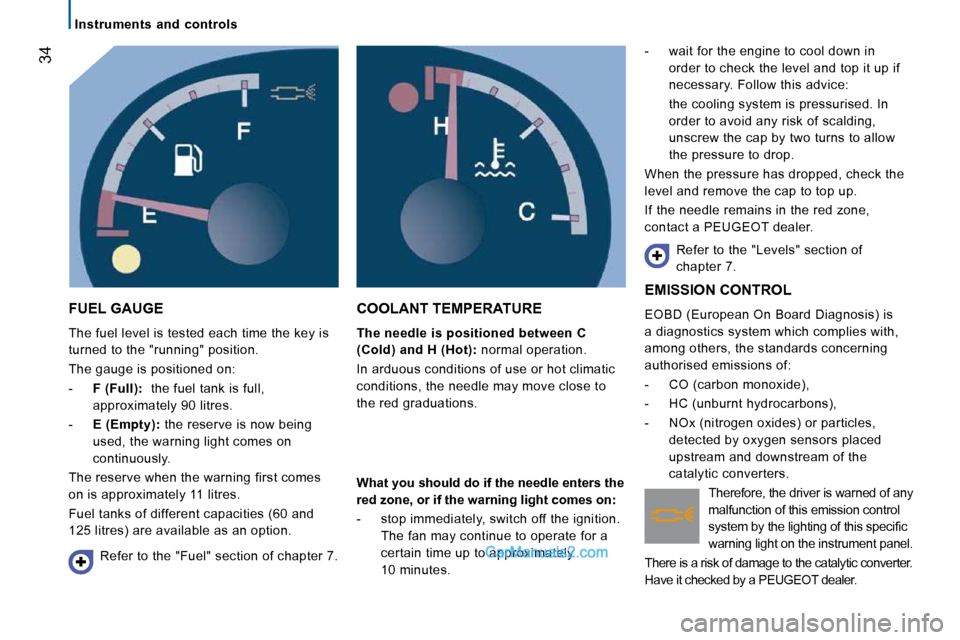
Instruments and controls
34
FUEL GAUGE
The fuel level is tested each time the key is
turned to the "running" position.
The gauge is positioned on:
- F (Full): the fuel tank is full,
approximately 90 litres.
- E (Empty): the reserve is now being
used, the warning light comes on
continuously.
The reserve when the warning first comes
on is approximately 11 litres.
Fuel tanks of different capacities (60 and
125 litres) are available as an option.
COOLANT TEMPERATURE
The needle is positioned between C
(Cold) and H (Hot): normal operation.
In arduous conditions of use or hot climatic
conditions, the needle may move close to
the red graduations. - wait for the engine to cool down in
order to check the level and top it up if
necessary. Follow this advice:
the cooling system is pressurised. In order to avoid any risk of scalding,
unscrew the cap by two turns to allow
the pressure to drop.
When the pressure has dropped, check the
level and remove the cap to top up.
If the needle remains in the red zone,
contact a PEUGEOT dealer.
Refer to the "Levels" section of
chapter 7.
Refer to the "Fuel" section of chapter 7.
What you should do if the needle enters the
red zone, or if the warning light comes on:
- stop immediately, switch off the ignition. The fan may continue to operate for a
certain time up to approximately
10 minutes.
EMISSION CONTROL
EOBD (European On Board Diagnosis) is
a diagnostics system which complies with,
among others, the standards concerning
authorised emissions of:
- CO (carbon monoxide),
- HC (unburnt hydrocarbons),
- NOx (nitrogen oxides) or particles, detected by oxygen sensors placed
upstream and downstream of the
catalytic converters.
Therefore, the driver is warned of any
malfunction of this emission control
�s�y�s�t�e�m� �b�y� �t�h�e� �l�i�g�h�t�i�n�g� �o�f� �t�h�i�s� �s�p�e�c�i�fi� �c�
warning light on the instrument panel.
There is a risk of damage to the catalytic convert er.
Have it checked by a PEUGEOT dealer.
Page 32 of 167
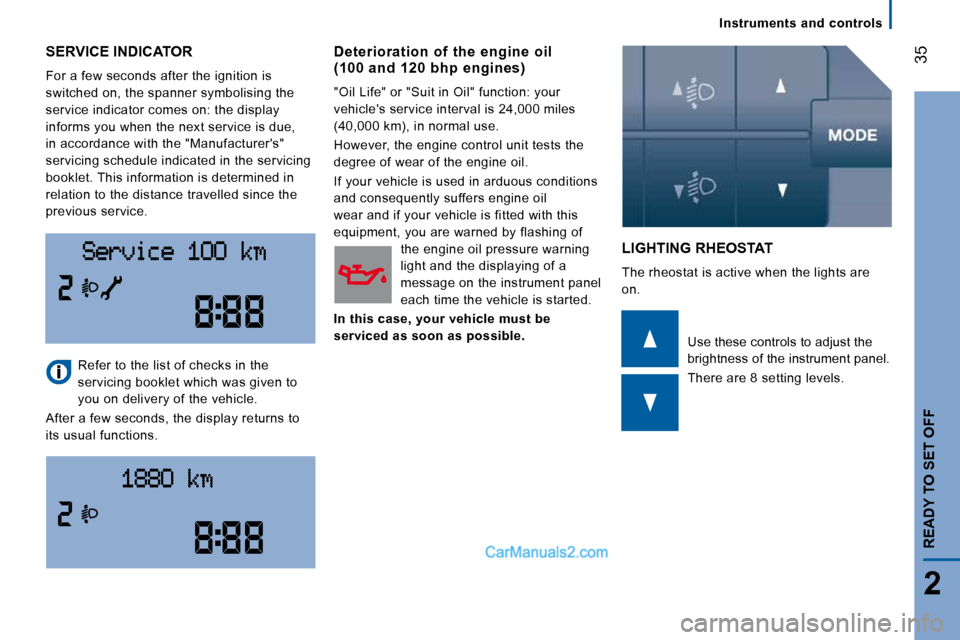
Instruments and controls
35
2
READY TO SET OFF
SERVICE INDICATOR
For a few seconds after the ignition is
switched on, the spanner symbolising the
service indicator comes on: the display
informs you when the next service is due,
in accordance with the "Manufacturer's"
servicing schedule indicated in the servicing
booklet. This information is determined in
relation to the distance travelled since the
previous service.
LIGHTING RHEOSTAT
The rheostat is active when the lights are
on.
Refer to the list of checks in the
servicing booklet which was given to
you on delivery of the vehicle.
After a few seconds, the display returns to
its usual functions. Use these controls to adjust the
brightness of the instrument panel.
There are 8 setting levels.
Deterioration of the engine oil (100 and 120 bhp engines)
"Oil Life" or "Suit in Oil" function: your
vehicle's service interval is 24,000 miles
(40,000 km), in normal use.
However, the engine control unit tests the
degree of wear of the engine oil.
If your vehicle is used in arduous conditions
and consequently suffers engine oil
wear and if your vehicle is fitted with this
equipment, you are warned by flashing of
the engine oil pressure warning
light and the displaying of a
message on the instrument panel
each time the vehicle is started.
In this case, your vehicle must be
serviced as soon as possible.
Page 33 of 167
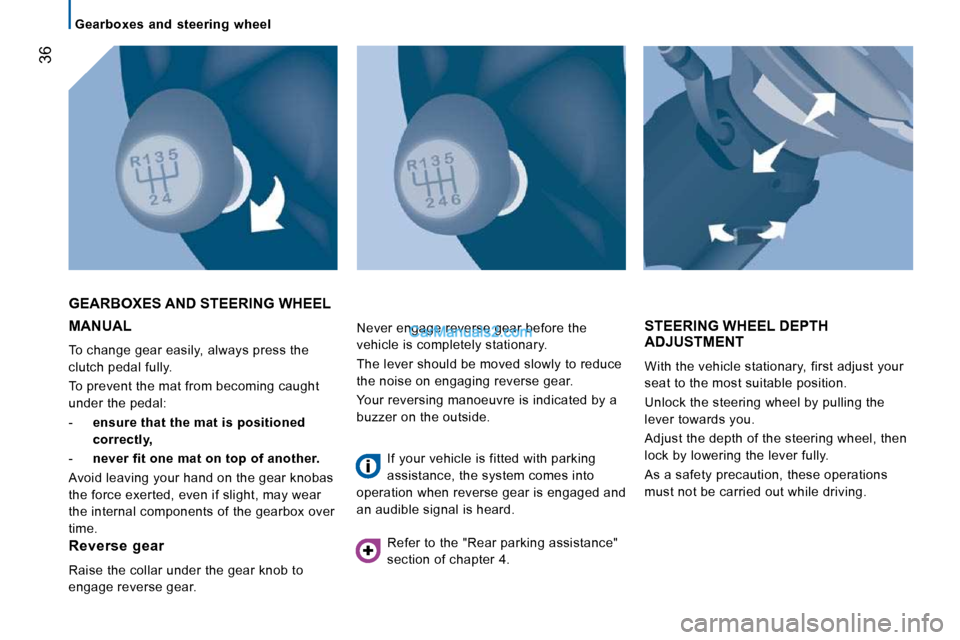
36
Gearboxes and steering wheel
MANUAL
To change gear easily, always press the
clutch pedal fully.
To prevent the mat from becoming caught
under the pedal:
- ensure that the mat is positioned
correctly,
- never fit one mat on top of another.
Avoid leaving your hand on the gear knobas
the force exerted, even if slight, may wear
the internal components of the gearbox over
time.
GEARBOXES AND STEERING WHEEL
STEERING WHEEL DEPTH ADJUSTMENT
With the vehicle stationary, first adjust your
seat to the most suitable position.
Unlock the steering wheel by pulling the
lever towards you.
Adjust the depth of the steering wheel, then
lock by lowering the lever fully.
As a safety precaution, these operations
must not be carried out while driving.
Reverse gear
Raise the collar under the gear knob to
engage reverse gear. Never engage reverse gear before the
vehicle is completely stationary.
The lever should be moved slowly to reduce
the noise on engaging reverse gear.
Your reversing manoeuvre is indicated by a
buzzer on the outside.
If your vehicle is fitted with parking
assistance, the system comes into
operation when reverse gear is engaged and
an audible signal is heard.
Refer to the "Rear parking assistance"
section of chapter 4.
Page 34 of 167
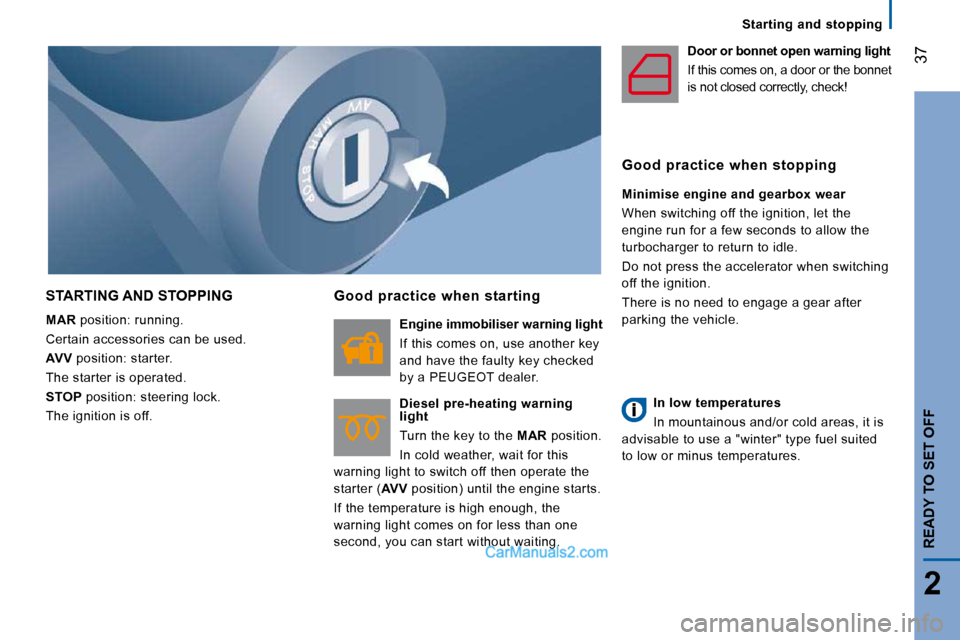
37
2
READY TO SET OFF
Starting and stopping
STARTING AND STOPPING
MAR position: running.
Certain accessories can be used.
AVV position: starter.
The starter is operated.
STOP position: steering lock.
The ignition is off.
Good practice when starting
Engine immobiliser warning light
If this comes on, use another key
and have the faulty key checked
by a PEUGEOT dealer.
Diesel pre-heating warning
light
Turn the key to the MAR position.
In cold weather, wait for this
warning light to switch off then operate the
starter ( AVV position) until the engine starts.
If the temperature is high enough, the
warning light comes on for less than one
second, you can start without waiting. Door or bonnet open warning light
If this comes on, a door or the bonnet
is not closed correctly, check!
Good practice when stopping
Minimise engine and gearbox wear
When switching off the ignition, let the
engine run for a few seconds to allow the
turbocharger to return to idle.
Do not press the accelerator when switching
off the ignition.
There is no need to engage a gear after
parking the vehicle.
In low temperatures
In mountainous and/or cold areas, it is
advisable to use a "winter" type fuel suited
to low or minus temperatures.
Page 35 of 167
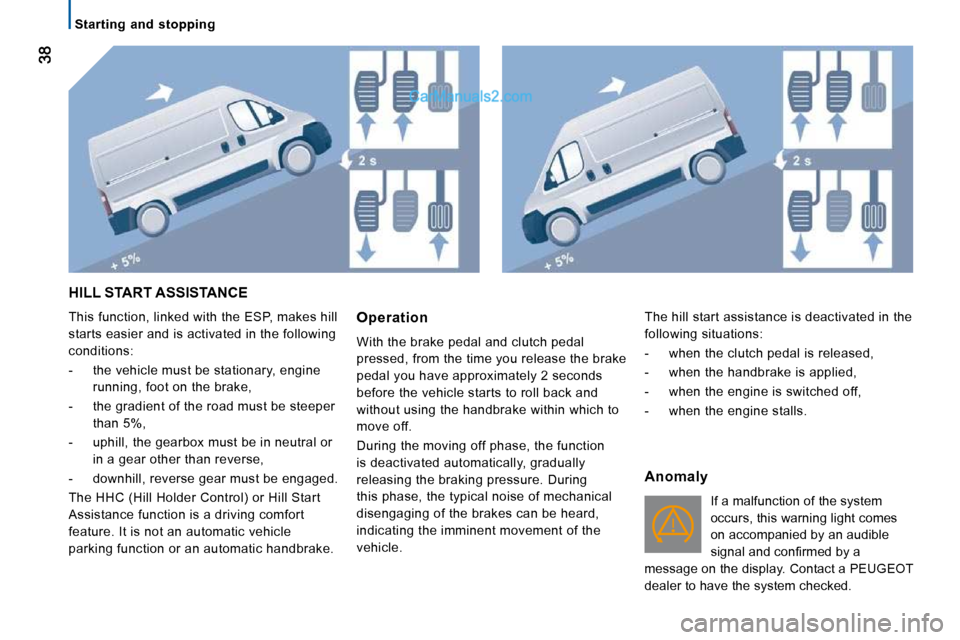
Starting and stopping
HILL START ASSISTANCE
This function, linked with the ESP, makes hill
starts easier and is activated in the following
conditions:
- the vehicle must be stationary, engine running, foot on the brake,
- the gradient of the road must be steeper than 5%,
- uphill, the gearbox must be in neutral or in a gear other than reverse,
- downhill, reverse gear must be engaged.
The HHC (Hill Holder Control) or Hill Start
Assistance function is a driving comfort
feature. It is not an automatic vehicle
parking function or an automatic handbrake. Operation
With the brake pedal and clutch pedal
pressed, from the time you release the brake
pedal you have approximately 2 seconds
before the vehicle starts to roll back and
without using the handbrake within which to
move off.
During the moving off phase, the function
is deactivated automatically, gradually
releasing the braking pressure. During
this phase, the typical noise of mechanical
disengaging of the brakes can be heard,
indicating the imminent movement of the
vehicle.
Anomaly
If a malfunction of the system
occurs, this warning light comes
on accompanied by an audible
�s�i�g�n�a�l� �a�n�d� �c�o�n�fi� �r�m�e�d� �b�y� �a�
message on the display. Contact a PEUGEOT
dealer to have the system checked.
The hill start assistance is deactivated in the
following situations:
- when the clutch pedal is released,
- when the handbrake is applied,
- when the engine is switched off,
- when the engine stalls.
Page 36 of 167
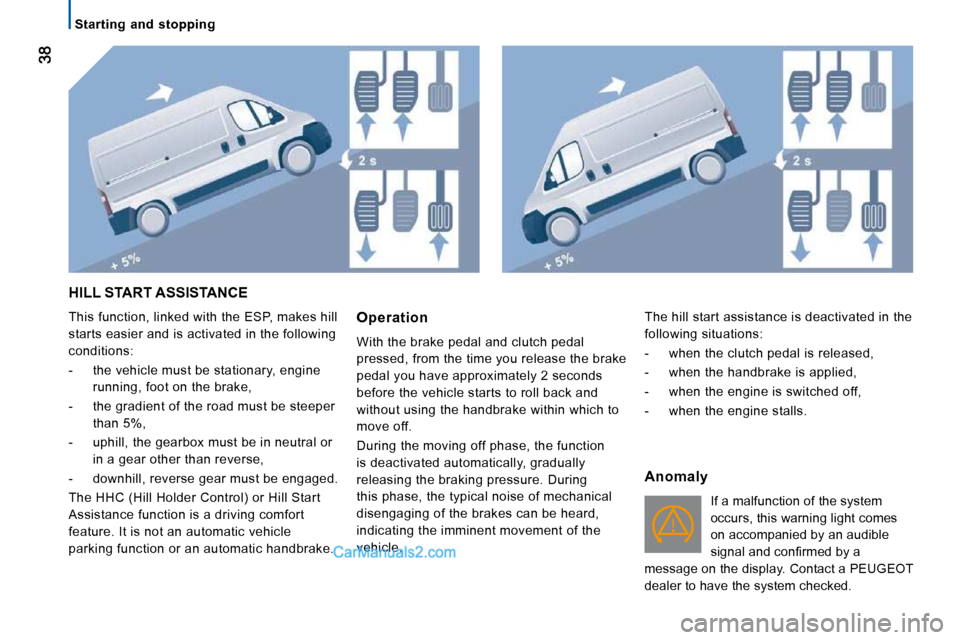
Starting and stopping
HILL START ASSISTANCE
This function, linked with the ESP, makes hill
starts easier and is activated in the following
conditions:
- the vehicle must be stationary, engine running, foot on the brake,
- the gradient of the road must be steeper than 5%,
- uphill, the gearbox must be in neutral or in a gear other than reverse,
- downhill, reverse gear must be engaged.
The HHC (Hill Holder Control) or Hill Start
Assistance function is a driving comfort
feature. It is not an automatic vehicle
parking function or an automatic handbrake. Operation
With the brake pedal and clutch pedal
pressed, from the time you release the brake
pedal you have approximately 2 seconds
before the vehicle starts to roll back and
without using the handbrake within which to
move off.
During the moving off phase, the function
is deactivated automatically, gradually
releasing the braking pressure. During
this phase, the typical noise of mechanical
disengaging of the brakes can be heard,
indicating the imminent movement of the
vehicle.
Anomaly
If a malfunction of the system
occurs, this warning light comes
on accompanied by an audible
�s�i�g�n�a�l� �a�n�d� �c�o�n�fi� �r�m�e�d� �b�y� �a�
message on the display. Contact a PEUGEOT
dealer to have the system checked.
The hill start assistance is deactivated in the
following situations:
- when the clutch pedal is released,
- when the handbrake is applied,
- when the engine is switched off,
- when the engine stalls.
Page 37 of 167
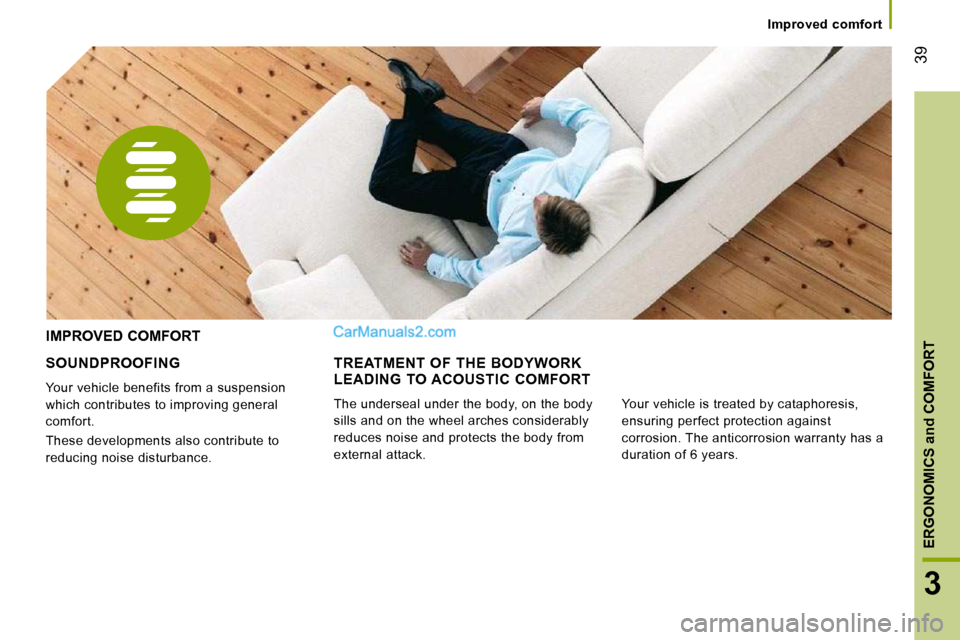
Improved comfort
39
3
ERGONOMICS and COMFORT
SOUNDPROOFING
Your vehicle benefits from a suspension
which contributes to improving general
comfort.
These developments also contribute to
reducing noise disturbance.
IMPROVED COMFORT
TREATMENT OF THE BODYWORK LEADING TO ACOUSTIC COMFORT
The underseal under the body, on the body
sills and on the wheel arches considerably
reduces noise and protects the body from
external attack. Your vehicle is treated by cataphoresis,
ensuring perfect protection against
corrosion. The anticorrosion warranty has a
duration of 6 years.
Page 38 of 167
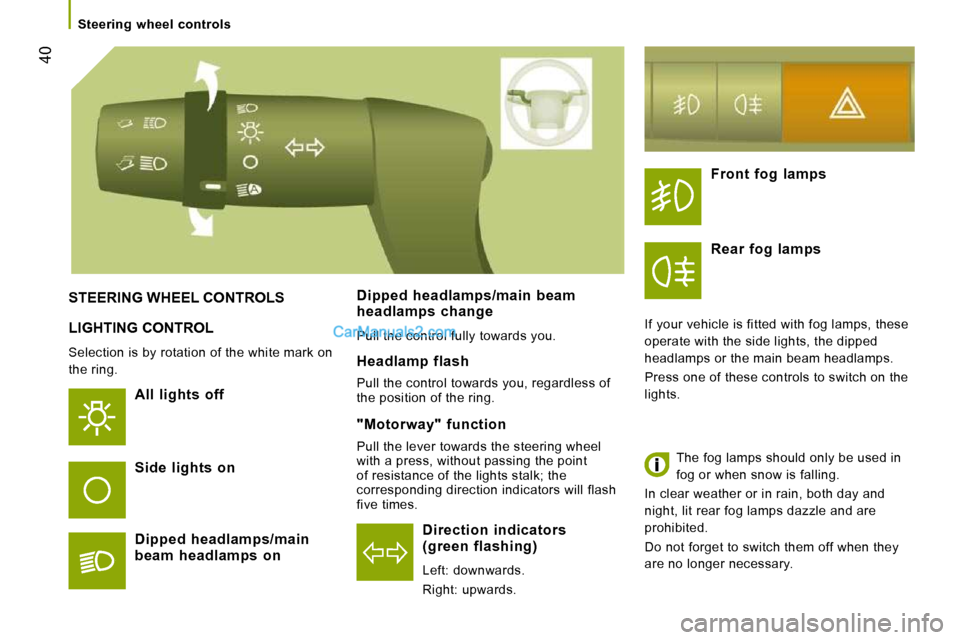
40
Steering wheel controls
LIGHTING CONTROL
Selection is by rotation of the white mark on
the ring.
All lights off
Direction indicators (green flashing)
Left: downwards.
Right: upwards.
STEERING WHEEL CONTROLS
Side lights on
Dipped headlamps/main beam headlamps on
Dipped headlamps/main beam headlamps change
Pull the control fully towards you.
Headlamp flash
Pull the control towards you, regardless of
the position of the ring.
Front fog lamps
Rear fog lamps
If your vehicle is fitted with fog lamps, these
operate with the side lights, the dipped
headlamps or the main beam headlamps.
Press one of these controls to switch on the
lights. The fog lamps should only be used in
fog or when snow is falling.
In clear weather or in rain, both day and
night, lit rear fog lamps dazzle and are
prohibited.
Do not forget to switch them off when they
are no longer necessary.
"Motorway" function
Pull the lever towards the steering wheel
with a press, without passing the point
of resistance of the lights stalk; the
corresponding direction indicators will flash
five times.
Page 39 of 167
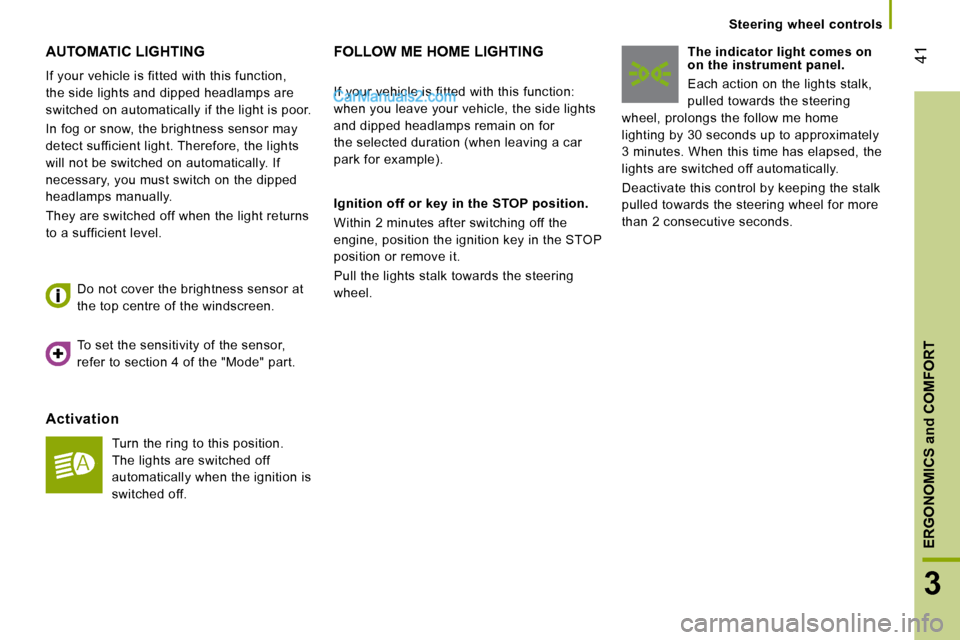
41
3
ERGONOMICS and COMFORT
Steering wheel controls
AUTOMATIC LIGHTING
If your vehicle is fitted with this function,
the side lights and dipped headlamps are
switched on automatically if the light is poor.
In fog or snow, the brightness sensor may
detect sufficient light. Therefore, the lights
will not be switched on automatically. If
necessary, you must switch on the dipped
headlamps manually.
They are switched off when the light returns
to a sufficient level.
Activation
Turn the ring to this position.
The lights are switched off
automatically when the ignition is
switched off.
Do not cover the brightness sensor at
the top centre of the windscreen.
FOLLOW ME HOME LIGHTING
Ignition off or key in the STOP position.
Within 2 minutes after switching off the
engine, position the ignition key in the STOP
position or remove it.
Pull the lights stalk towards the steering
wheel. The indicator light comes on
on the instrument panel.
Each action on the lights stalk,
pulled towards the steering
wheel, prolongs the follow me home
lighting by 30 seconds up to approximately
3 minutes. When this time has elapsed, the
lights are switched off automatically.
Deactivate this control by keeping the stalk
pulled towards the steering wheel for more
than 2 consecutive seconds.
If your vehicle is fitted with this function:
when you leave your vehicle, the side lights
and dipped headlamps remain on for
the selected duration (when leaving a car
park for example).
To set the sensitivity of the sensor,
refer to section 4 of the "Mode" part.
Page 40 of 167
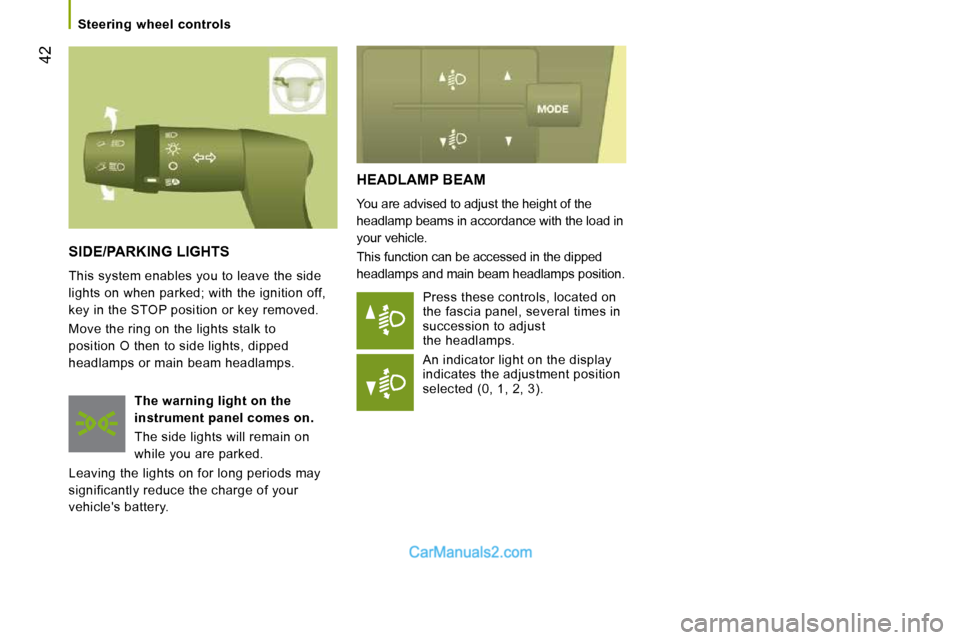
42
Steering wheel controls
HEADLAMP BEAM
You are advised to adjust the height of the
headlamp beams in accordance with the load in
your vehicle.
This function can be accessed in the dipped
headlamps and main beam headlamps position. Press these controls, located on
the fascia panel, several times in
succession to adjust
the headlamps.
An indicator light on the display
indicates the adjustment position
selected (0, 1, 2, 3).
SIDE/PARKING LIGHTS
This system enables you to leave the side
lights on when parked; with the ignition off,
key in the STOP position or key removed.
Move the ring on the lights stalk to
position O then to side lights, dipped
headlamps or main beam headlamps.
The warning light on the
instrument panel comes on.
The side lights will remain on
while you are parked.
Leaving the lights on for long periods may
significantly reduce the charge of your
vehicle's battery.